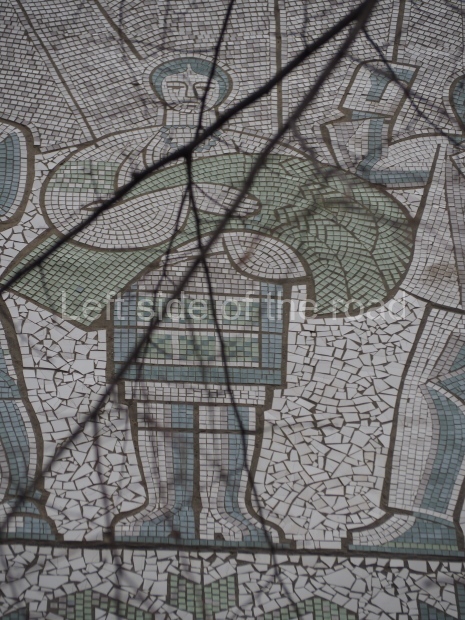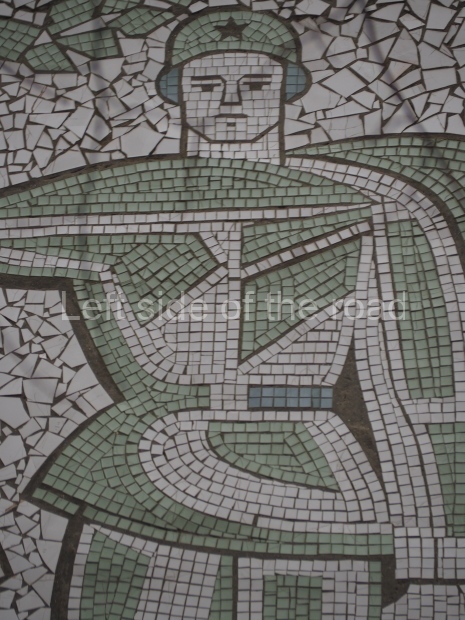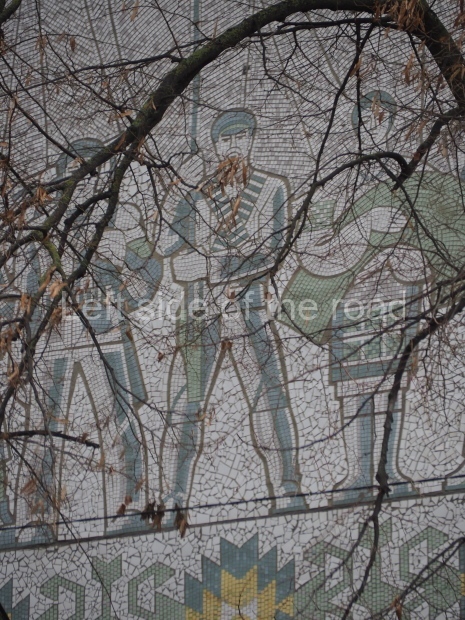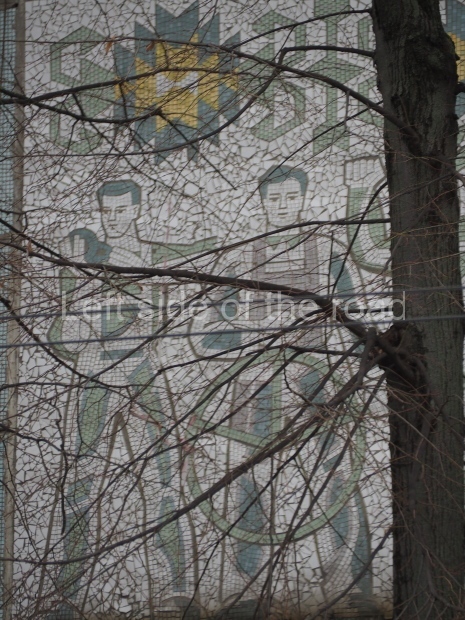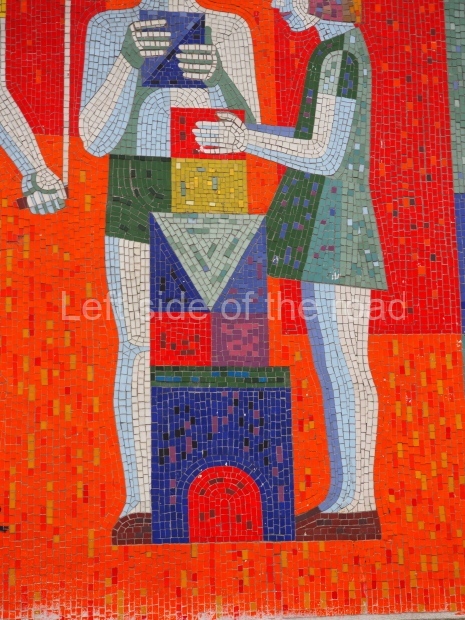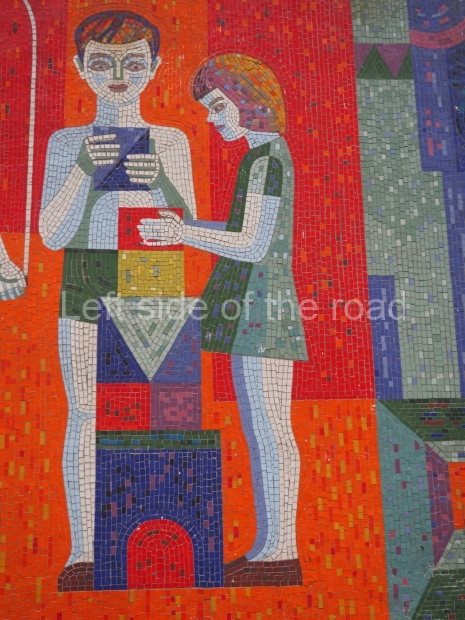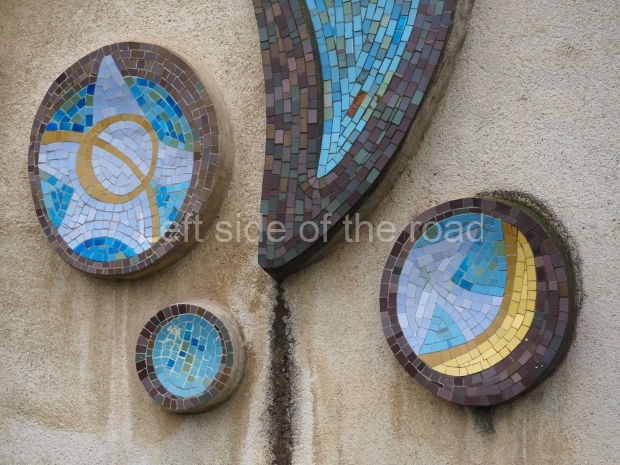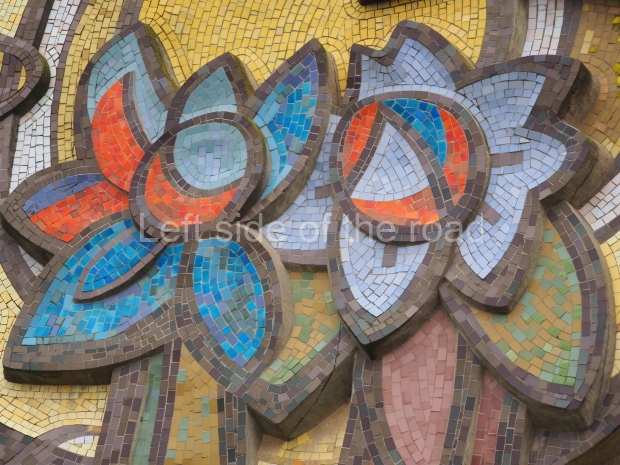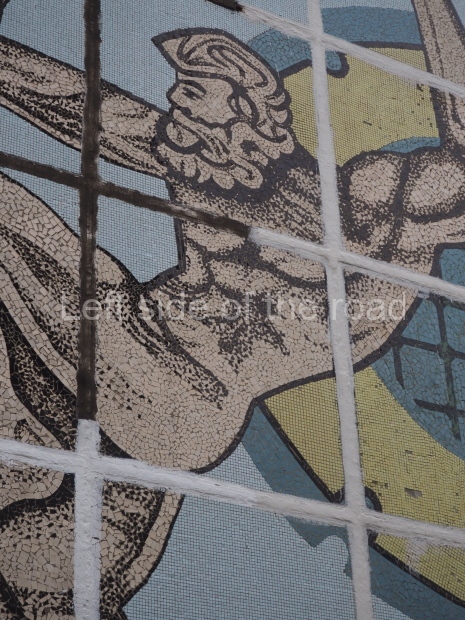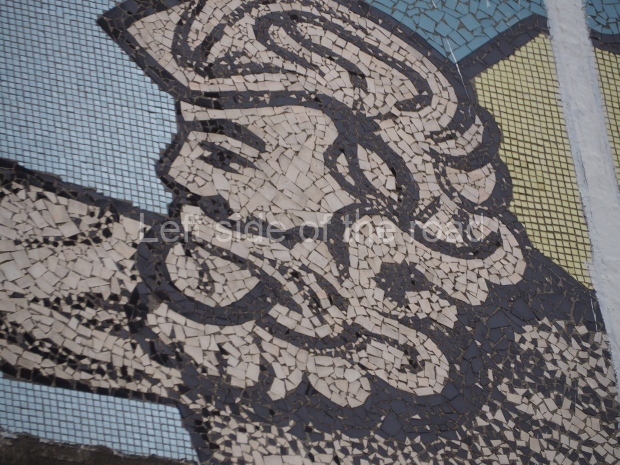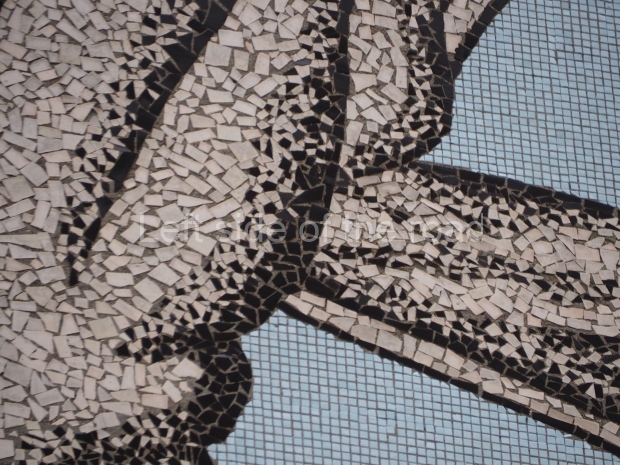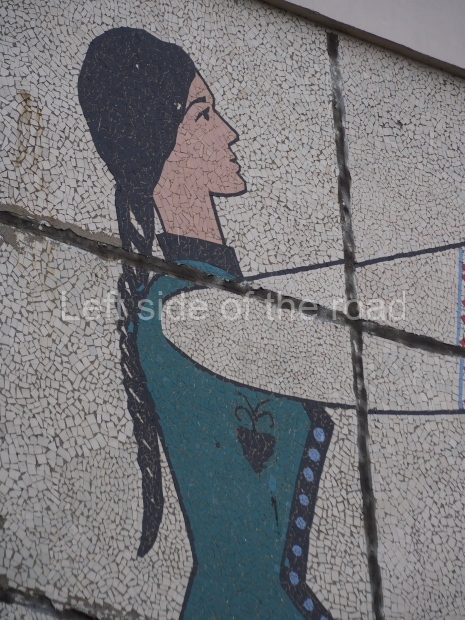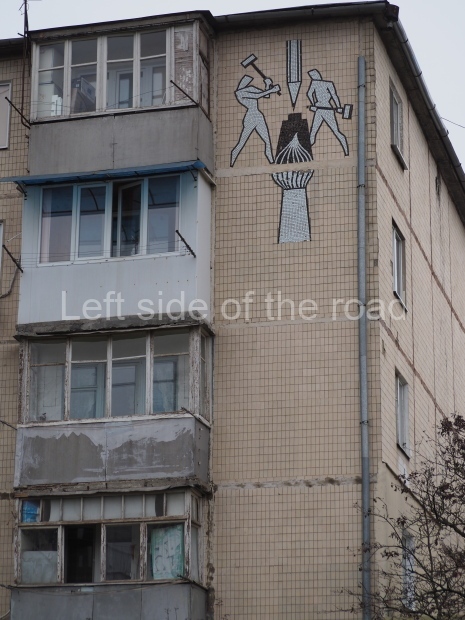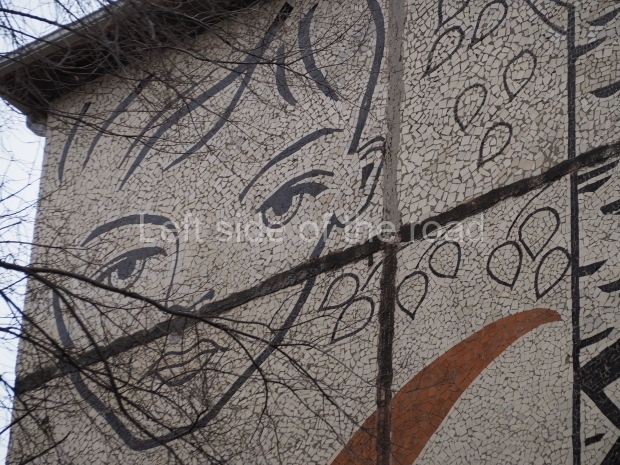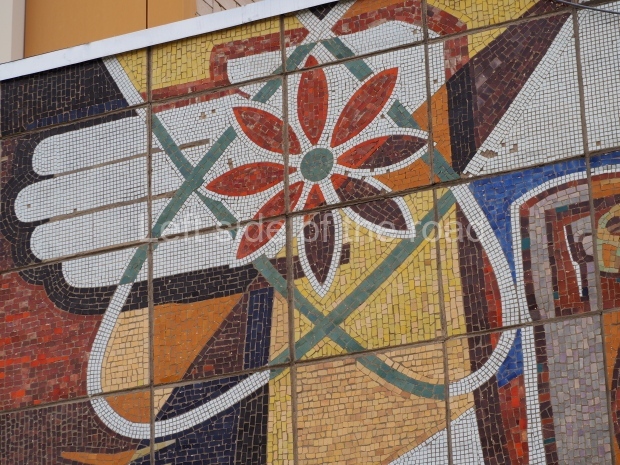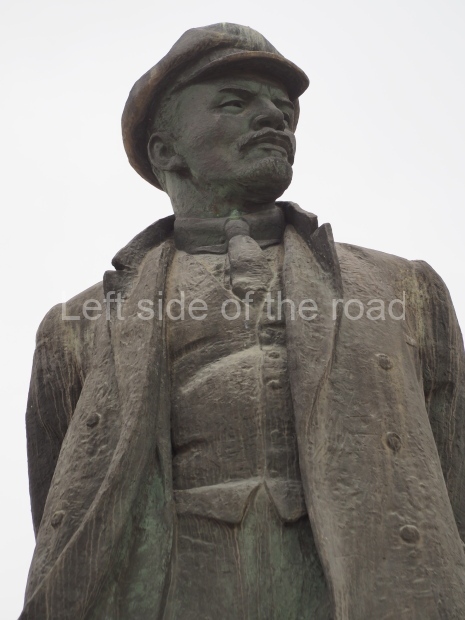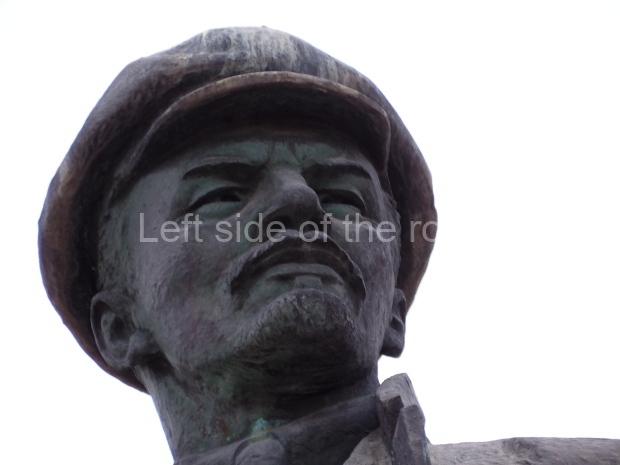More on Moldova – on the Post-Socialist Countries – Eastern Europe and Asia page
Cultural Palace high reliefs – Bălți – Moldova
This is another Soviet era work of art that is hidden by the vegetation but unlike the nearby mosaic with the image of Lenin at the Palace of Culture the high bas relief has been consciously allowed to be obscured from public view.
Although not necessarily unique I don’t think I’ve seen a similar such bas relief in my travels.
It’s located on the outside wall of Bălți’s still Palace of Culture, to the right of the main entrance. This building is located on the north eastern side of the city’s central square, a square which is also the home of the Tank War Memorial with its Eternal Flame.
Originally this high bas relief was intended to be seen in its entirety but that is impossible now. Two of its three components are entirely hidden by evergreen trees (so don’t even come into partial view – as is the case with the Lenin mosaic) during the winter and only one half of the left hand side panel is not obscured by the trees.
However, by getting between the trees and the walls it is possible to ‘read’ the story.
The central grouping is of a man and a woman – shown in a very stylised form. The woman, wearing a voluminous skirt, is shown facing the viewer and her left arm is outstretched and in her hand she holds a large sickle. Her right arm is just held out in front of the male’s body, the palm of her hand facing the viewer but not adding anything to the composition.
The male is looking to his right hand side but his left arm is outstretched behind the female and in his hand he holds a large hammer, the head of which is at the top and this is touching the sickle of the women. Here we have a representation of the Soviet Union, with the ubiquitous (still – at least in places, especially Moscow) Hammer and Sickle.
I’m at a loss to understand the imagery of what the male holds in his right hand. His right arm is outstretched and resting in the palm of his hand is a large circular object from which extend three spokes, towards his face. I have tried to think what this might represent due to its location (the Palace of Culture) but have failed, so far, to come up with any ideas that make any sense.
Unfortunately, most of his right arm is missing and the disembodied hand seems to be floating in the air. Although it’s a shame that no effort has been made to repair this damage it does offer a view into how the sculpture was constructed. All the figures were made in moulded, concrete sections in a workshop and then brought to the location and then bolted to the wall. Apart from the missing arm there’s a small amount of moss growing on the upper bodies of both the individuals.
The second of the three groupings, this one on the right as you try to look through the trees, is one of four, three adults and a small child. On the left, kneeling, is a female, presumably the mother of the small boy who is standing, with both his arms outstretched towards the standing male. Unfortunately, we don’t know what the child is after. Here, again, due to lack of care and maintenance the right arm of the male is missing so we don’t know if the child just wants to be picked up by the male or wants what he has in his land. Standing to the right of the male is a woman who is clutching a small stack of four books close to her body with both hands. To her right is a flower design, indicating a garden?, which is very reminiscent of the mosaic that can be found at the side of the (now unused) main entrance to Bălți’s long distance bus station.
Apart from the missing section of the arm of the standing male this particular panel shows the effects of the environment more than the other two. The close proximity of the trees, the fact that there’s little air circulation means that during the winter months this part of the wall would be damp for most of the time and this has led, over time, to the growth of moss on the sculpture, especially around the head, neck and shoulders of the woman.
The third and final grouping is that of five musicians, the two on the left most side being the only ones that are easily seen by anyone passing by. Hidden behind the trees there’s a male cellist and next to him a male violinist. The middle musician is hidden by the the tree (whose branches were almost touching when I visited) so it isn’t possible to work out what he is playing. However, the two at the end seem to be playing traditional, folk instruments. The one that’s standing is playing what looks like a flute – so this could be either a fluier or a taragot, traditional Moldovan wooden flutes. The final musician, crouched down, is playing what likes a small version of a nai (or mascal), a ‘Romanian diatonic pan flute’, with five or six short tubes over the top of which the musician is blowing. Readers might be familiar with the Andean pan pipes – this looks very similar.
What is interesting here is that in the image of the musicians we have both traditional Moldovan instruments together with classical, stringed instruments from western Europe. My assumption here is that the image is conveying that both traditional and ‘classical’ music would have been played in the concerts that took place in the Palace of Culture in Soviet times.
Whether the damage, and hence missing sections, of the sculpture were due to lack of care or deliberate vandalism is impossible to say. However, the biggest threat to the sculpture now is the moss growth on some parts of the sculpture. Whereas, the trees close to the Lenin mosaic might have played a role in protecting it the trees by the Palace of Culture are having the opposite effect, they are creating an environment that is wholly detrimental to the sculpture and the fact that they hide the most of the art work means that few people are likely to be aware of the damage that is being caused on a daily basis.
Location;
Strada Dostoevschi 24
GPS;
47.75767 N
27.92493 E
More on Moldova – on the Post-Socialist Countries – Eastern Europe and Asia page






























